| December 17, 2020 |
| NAAA’s 2020 Ag Aviation Expo Comes in for Safe Landing |
|
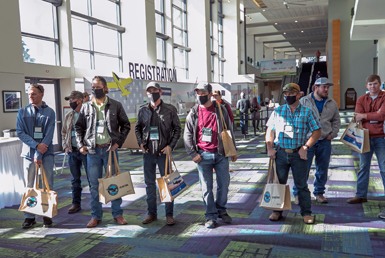 The 2020 Ag Aviation Expo was held in person in Savannah last week and is sure to be one that attendees remember for a long time. Not surprisingly, this year’s event was a smaller affair, featuring fewer exhibitors and attendees, but the fact that the Ag Aviation Expo was held at all made its successful conclusion extremely satisfying. What NAAA’s attendees and exhibitors lacked in terms of numbers was compensated by the high spirits on display at NAAA’s education sessions, receptions and trade show. Moreover, the health and safety protocols NAAA implemented achieved their desired effect. In the early returns for NAAA’s attendee survey, 100% stated they arrived home safe and healthy. The 2020 Ag Aviation Expo was held in person in Savannah last week and is sure to be one that attendees remember for a long time. Not surprisingly, this year’s event was a smaller affair, featuring fewer exhibitors and attendees, but the fact that the Ag Aviation Expo was held at all made its successful conclusion extremely satisfying. What NAAA’s attendees and exhibitors lacked in terms of numbers was compensated by the high spirits on display at NAAA’s education sessions, receptions and trade show. Moreover, the health and safety protocols NAAA implemented achieved their desired effect. In the early returns for NAAA’s attendee survey, 100% stated they arrived home safe and healthy.
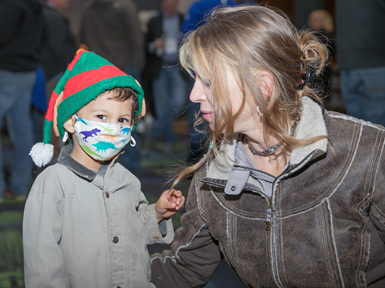
Here are some of the highlights from NAAA’s unique 2020 Ag Aviation Expo. Let’s review!
MONDAY, DEC. 7
Kickoff Speaker Mixes Fearless Forecasts with Laughs
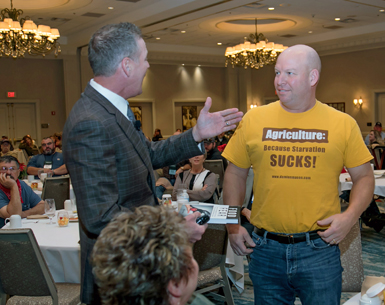 NAAA member Eric Klindt models a humorous T-shirt that Damon Mason sells. NAAA member Eric Klindt models a humorous T-shirt that Damon Mason sells.
The convention got off to a flying start at Monday’s Kickoff Breakfast with an address by Damian Mason, an agricultural economist, futurist, author, podcaster and comedian. At root, Mason is a trained professional observer, and he credits his comedy background for honing his powers of observation. “To be a comedian is to be a professional observer,” he said. “That’s what comedy is: observation, report your perspective, deliver a punchline.” Mason generated several laughs throughout his address as he shared his perspectives on where he sees the business of agriculture headed. He did so by making a series of predictions, which you can read more about here.
2020 NAAA ‘Ag Wings of Tomorrow’ Scholarships Awarded
The Kickoff Breakfast was sponsored by BASF, which also co-sponsored the 2020 NAAA “Ag Wings of Tomorrow” Scholarship program with Thrush Aircraft. This year was BASF’s 11th of sponsoring the scholarship and Thrush’s fourth year of co-sponsoring it. Thanks to their generous support, NAAA awarded $5,000 scholarships to four aspiring ag pilots who applied for the 2020 scholarship. Before Mason’s talk, John Sabatka from BASF announced the 2020 “Ag Wings of Tomorrow” Scholarship recipients in a prerecorded video message. They include:
- Alexander “Zander” Baumann of Manitowoc, Wisconsin
- Curtis Grimes of Garden City, Missouri
- Benjamin Ramos of Yuma, Arizona
- Dabid Romero of Gooding, Idaho
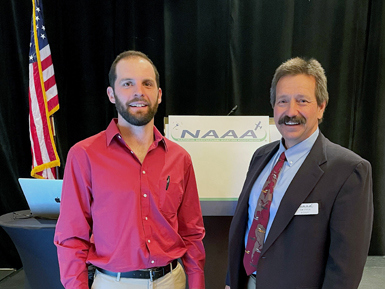 Curtis Grimes (left), with his sponsor, Sam Styron, was one of four men to receive a $5,000 scholarship from the 2020 “Ag Wings of Tomorrow” Scholarship program. Curtis Grimes (left), with his sponsor, Sam Styron, was one of four men to receive a $5,000 scholarship from the 2020 “Ag Wings of Tomorrow” Scholarship program.
Scholarship applicants had to be sponsored by an NAAA operator member to apply. Baumann was sponsored by Dean Heimermann, of Countryside Aviation, in Chilton, Wisconsin. Sam Styron of 1Lowflyer Inc. in Harrisonville, Missouri, sponsored Grimes. Miles Morris of Morris Ag Air Southwest in Yuma, Arizona, sponsored Ramos, and Rod Thomas, of Thomas Helicopters in Gooding, Idaho, sponsored Romero.
Aerial Application Technology Research Session
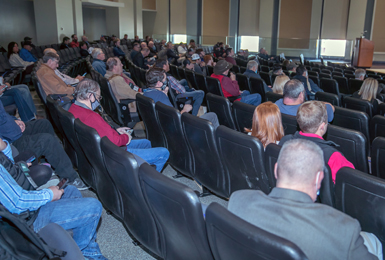 The 2020 Aerial Application Technology Research Session presentations were delivered to attendees virtually. The 2020 Aerial Application Technology Research Session presentations were delivered to attendees virtually.
The Aerial Application Technology Research Session was presented using six prerecorded presentations since every one of the researchers came from an institution that prohibited travel to meetings and conferences. The presenters were available for questions from the in-person audience through a Zoom meeting.
Sam Marx from the University of Nebraska-Lincoln talked about how the variation in an ag aircraft’s spray swath is measured and how to lower variation to improve application uniformity. Chenghai Yang, with the USDA-ARS Aerial Application Technology Research Unit, discussed how to use satellite imagery to identify cotton fields to assist with the boll weevil eradication program. Next from the USDA Aerial Application Technology Research Unit was Brad Fritz, who provided an overview of the different types of nozzles available for aerial applications. Randy Price from the LSU AgCenter discussed his development of a new type of spray pattern analysis equipment for agricultural aircraft. An estimated total value of the agricultural aviation industry was the focus of the research results presented by Senarath Dharmasena of Texas A&M University. The final talk was given by Dan Martin, also with USDA Aerial Application Technology Research Unit, who summarized results comparing deposition and efficacy for different nozzle types and spray application volumes for aerial weed control applications.
A more thorough review of the research presented during this session will appear in the Winter 2021 issue of Agricultural Aviation.
Aerial Imaging and Low-Altitude Airspace Sessions Focus on Crop Scouting and Ag Aircraft Flying Characterizations to Possibly Protect Against Drones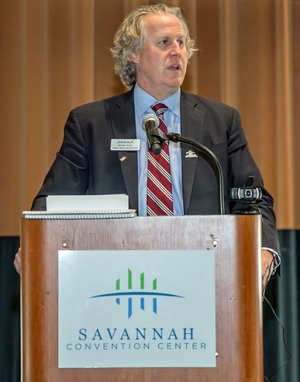 NAAA’s typical session on drones and FAA policy morphed this year to focus on federal policy pertaining to low-altitude obstacles, but also aerial imaging and a study characterizing ag aircraft in flight as a precursor to ultimately develop a safety buffer between low-flying manned aircraft and drones. NAAA CEO Andrew Moore, Madison Dixon, the UAS program manager at Mississippi State University, and AgroScout Sales Director Tim Kustka led the first session. NAAA’s typical session on drones and FAA policy morphed this year to focus on federal policy pertaining to low-altitude obstacles, but also aerial imaging and a study characterizing ag aircraft in flight as a precursor to ultimately develop a safety buffer between low-flying manned aircraft and drones. NAAA CEO Andrew Moore, Madison Dixon, the UAS program manager at Mississippi State University, and AgroScout Sales Director Tim Kustka led the first session.
Moore discussed federal low-level altitude obstacle policy matters due to the FAA and other government representatives’ inability to attend. He stated that in March of 2020 NAAA submitted comments to the FAA on its proposed rule for tracking and identifying unmanned aerial systems (UAS). NAAA commented in support of the FAA proposal that drones over 0.55 pounds be equipped with tracking and identification technology. NAAA also commented that certain recreational and government drones exempt from the tracking and ID technology not be able to fly in areas where there is manned aircraft activity.
Moore also reported that the legislation enacted in 2018 to require towers less than 10 feet in diameter at the base and between 50 feet and 200 feet AGL to be either marked or logged (both would be required for meteorological evaluation towers) into an FAA public database is stalled at the FAA. In recent conversations with the FAA, NAAA has been told that promulgation of the legislation is still in the lineup; however, it is considered a low priority. NAAA will be using congressional pressure to get the FAA to promulgate the rule.
Tim Kustka of AgroScout presented on using its crop sensing DJI drone to perform aerial imaging to scout crops. The AgroScout system can image and scout 5,000 plants in the same amount of time it would take a crop consultant to observe 150 plants by foot. Plus, the system can be used autonomously, and it won’t bring in contaminants such as spores, seeds and insects from an infected field to a clean field from shoes. Presently, the system is being used by PepsiCo and Pizzoli in their operations.
The session ended with questions and answers covering different aspects of aerial crop scouting. There were also questions on how operations are done safely around obstructions, such as irrigation units. The response was that those units are equipped with geospatial coordinates that the drone can avoid. A discussion on how to protect manned agricultural aircraft from scouting drones was also mentioned, as was the possibility that aerial applicators could use the technology as another service platform to provide to their farmer-customers.
After the first session concluded, the second was presented virtually by Madison Dixon of Mississippi State University’s Raspet Flight Research Laboratory on its study titled “Characterization of Agricultural Aircraft Performance Using Flight Log Data.” Data for the study was collected from a three-year research effort made possible by the support of NAAA members through GPS flight log data contributions. The research aims to keep agricultural pilots and aircraft safe from drones by providing UAS operators with information on how to deconflict with agricultural aircraft.
In total, 28,448 total logs have been collected from 20 states (WA, CA, ID, CO, TX, ND, SD, NE, KS, TX, MN, WI, IA, IL, MS, AK, AL, AR, DE, MD). Multiple different ag aircraft were used, ranging from Weatherlys to Air Tractors, with interesting statistics including an average ferrying speed of 132.8 mph and an average spray speed of 139 mph. The data from the GPS logs submitted had all identifying information removed. The next steps for the Mississippi State University’s researchers include additional modeling and prediction of manned aircraft movements, simulation of UAS operations around ag aircraft, etc.
NAAA Engine Sessions
Several engine sessions were offered for turbine and radial powered aircraft over the course of the convention, beginning with a Pratt & Whitney Canada Session on Sunday, Dec. 6. The four-hour Sunday morning P&WC PT6 presentation was hosted by Covington Aircraft, with Robert Craymer and Fletcher Sharp presenting. There were approximately 45 attendees, and topics covered included basic PT6 descriptions, with most of the time spent addressing operator questions. From a perspective of questions asked by operators, this was an all-time high. There were a lot of very positive comments on how it was presented.
Fletcher Sharp moderated the Radial Engines Session. The only panelist was David Hamilton from Covington Aircraft. The audience, numbering 40 at its conclusion, included a growing number of new, young operators, which is a good thing.
Topics covered included the best way to operate a radial engine, which led to a lengthy discussion on how much throttle to use on takeoff. Some of the newer guys were doing reduce power takeoffs, and Hamilton pointed out that for takeoff only, the throttle should always be full forward to ensure as much gasoline as possible flows into the cylinders to provide additional cooling of the cylinder heads and help prevent cracking. The use of straight mineral oil versus Ashless Dispersant oil was addressed. The age component of many of the key radial engine parts was a hot topic. Most of what is available has been out there for 50 to 70 years or more, and no one is making new parts due to the design and production costs being astronomically high. As radial engines continue to age, certain key parts may become an issue.
The Honeywell TPE331 Session was led by NAAA Past President Perry Hofer, who pulled together a panel of -331 operators including himself, Barry Boyette, Matt Regier, Jeff Reabe, Mikel Hofer and Issac Wilde, who were willing to share their operating practices and procedures, including fuel nozzle maintenance best practices, oil sampling programs, and ensuring their fuel farm was kept in the best possible condition. All told, there were about 24 operators in this session. Hofer’s assistance was gratefully accepted!
For the P&WC PT6 Turbine Session, the four panelists were Robert Salyers from P&WC, Robert Craymer from Covington Aircraft, Will Wilson from Airforce Turbines and Jay Streb from Turbines Inc. Fletcher Sharp was the moderator. Topics discussed included the added value of the “Cool or Fast Start” kits, primarily for the larger -60 series of engines, the new P&WC oil analysis program, oil consumption rates, troubleshooting engine problems using data from a ground power run, compressor washing and turbine rinsing, best practices on engine shutdown procedures after the last flight of the day and fuel nozzle maintenance. For any turbine engines, clean air, clean fuel and clean oil can be large contributors to a good running engine. A brief review of a potential Airworthiness Directive aimed at all -34 series of engines was shared so that if the AD is issued, operators would have some background information. Attendance was around 45 operators.
Chemical Session
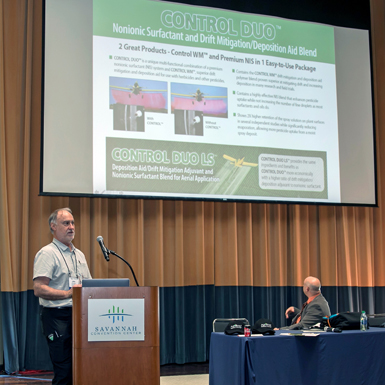 John Garr of GarrCo Products discusses some of his adjuvant products at the 2020 Chemical Session. John Garr of GarrCo Products discusses some of his adjuvant products at the 2020 Chemical Session.
Lynn Justesen of UPL moderated
the 2020 Chemical Session. He began the session talking about UPL, which offers
a large number of very established products. UPL has more than 80 registered
active ingredients in 278 different products. It is India-based with U.S.
headquarters in Pennsylvania. He finished up by talking about the importance of
adjuvants, which was a perfect segue to the other session presentations.
Steffan Busch with EGE Products began by talking about Length EXT, a next-generation polymer with residual encapsulation technology. Length EXT protects insecticides from being broken down by UV light, which increases the residual life of the insecticide. Length EXT will also decrease evaporation during the application. Busch finished up describing N-Line and J-Line, two different nitrogen stabilizers offered by EGE. N-Line is strictly a nitrogen stabilizer, while J-Line has both a nitrogen stabilizer and a nitrification inhibitor.
The next talk also focused on adjuvants. John Garr of GarrCo Products began his presentation with a discussion on the importance of spray droplet size and its impact on both coverage and drift potential. Control DUO offers both drift control and a nonionic surfactant (NIS) in one product and has been shown to increase pesticide deposition on leaves. Assist is a compatibility agent and water conditioner from GarrCo that can help create an effective spray mixture. Garr finished up by talking about Stimulate, a highly concentrated microbial product. Stimulate increases root mass, which in turn enhances water and nutrient uptake. It can be applied as a foliar application with any pesticide except paraquat and works with any crop.
TUESDAY, DEC. 8
NAAA General Session
The 2020 NAAA General Session examined legal, medical and food trends occurring in the ag aviation industry nationally. Aviation attorney John Wright participated by Zoom and started things off by discussing a pair of legal cases he tried in Colorado between an aggressive state government agency and two reputable aerial applicators. Agri Marketing magazine publisher Lynn Henderson also Zoomed in to provide an overview of how the landscape is changing within the food and agriculture sectors. Dr. Stan Musick, an aviator and AME, took the stage in person to cover several medical topics relevant to ag pilots, including over-the-counter drugs’ potency, fatigue and how to get a medical special issuance. Their presentations are covered more in-depth here.
NAAA Trade Show and Live Auction
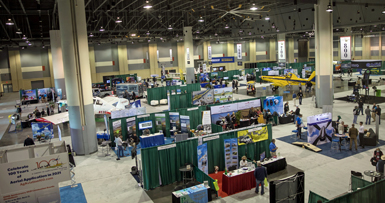 The NAAA Trade Show featured approximately 100 exhibitors, including three fixed-wing ag planes and two rotorcraft on display. Twenty-two companies and individuals donated items to NAAA’s 2020 Live Auction, including a brand-new PT6A-34AG engine donated by Pratt & Whitney Canada and purchased by winning bidder John Pew of Sarita Aerial Contractors Inc. in Arizona. The NAAA Trade Show featured approximately 100 exhibitors, including three fixed-wing ag planes and two rotorcraft on display. Twenty-two companies and individuals donated items to NAAA’s 2020 Live Auction, including a brand-new PT6A-34AG engine donated by Pratt & Whitney Canada and purchased by winning bidder John Pew of Sarita Aerial Contractors Inc. in Arizona.
WEDNESDAY, DEC. 9
Athena Program
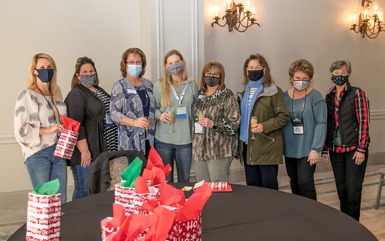
The 2020 Athena program presented at NAAA’s convention was titled “Personalities: Who Are You?” The purpose is to understand yourself better to serve others better. By understanding your personality, you can learn how to react and interpret the other person’s personality. The program was based on the DISC profile, which stands for Dominance, Influence, Steadiness and Conscientiousness.
Athena presenter Jane Barber-Pitlick delivered the program to 16 attendees and encouraged them to take the DISC personality test to gain insights about themselves and others and learn to adapt to better appreciate someone else’s personality “quirks.” The attendees were given the opportunity for a limited time to take the DISC personality test at no cost to them, courtesy of NAAA.
The WNAAA originally developed the Athena Project over 20 years ago for ag pilots’ wives to better understand the daily pressures pilots face while away from home. Its name comes from Greek mythology. Athena, the daughter of Zeus, was the goddess of wisdom, agriculture and handicrafts. The program is now under the purview of the NAAA Support Committee. Over the years, Athena’s presenters have developed the program with the assistance of the PAASS Program developers to broaden the audience to all those who work daily alongside ag pilots. The program has covered many topics, including emergency management, recordkeeping and insurance needs, pilot nutrition and personality traits.
Relationship Drift Session
Distractions are a common factor in many agricultural aviation accidents. Many distractions come from the cockpit, while others come from external stressors. These external stressors can be difficult customers, problems with employees and equipment maintenance issues. There is, however, a stressor that has nothing to do with agricultural aviation—stress from personal issues resulting from a relationship with a spouse or significant other. This stress, like any other, can cause a pilot to be distracted from the task at hand and increase the likelihood of an accident.
Last year the NAAREF Safety Session was titled “Relationship Drift” and focused specifically on this type of distraction. The goal of the session was to examine how personal relationships affect pilot decision-making and safety. Following the 2019 session’s success, NAAREF decided to hold another Relationship Drift Session at the 2020 Ag Aviation Expo.
This year it was presented by Darrin Pluhar and Sue Stewart. Stewart is an operator from Haskell, Texas, whose husband is a co-operator and an ag pilot. Pluhar is an operator and ag pilot who operates in Ekalaka, Montana. The session began with pilots and their spouses or significant others in the same room for an introduction and an overview of the program’s goals.
After that, the audience was split into two groups. Operator and pilot roles are largely but not exclusively the dominion of men, as a female ag pilot and a few female operators in the audience could attest, but for the sake of discussion, the audience was separated by gender into two groups. The women remained in the main room, and the men were escorted to another room.
Each group was presented with a series of similar questions designed to promote discussion focusing on the overall goal of understanding and reducing distraction caused by relationship stress. Polling was conducted with each group using an audience response system. Questions included when pilots and significant others should discuss how to handle non-work-related issues during the season, how much communication is appropriate during a busy day in the season, and how both pilots and their domestic partners can help their relationship stay on target during the busy part of the year. Also discussed was how to address urgent situations during the season and the appropriate time to communicate when an emergency occurs. All of the questions generated good discussions with participants sharing their individual experiences and thoughts.
After the two groups answered the questions and discussed their responses apart from each other, they reconvened together to review and discuss what each had to say about the topics covered by the questions. Pilots and their spouses or significant others were then able to share their thoughts on how to ensure their relationship stayed strong, with both parties’ individual needs being met, and at the same time ensure minimal distractions to help ensure pilot safety.
Helicopter Session
Longtime Helicopter Session moderator Jeff Reabe of Reabe Aircraft Improvement once again skillfully guided conversation and questions on topics ranging from cabin comfort, finding and retaining good employees, moving from piston to turbine powered helicopters, and the benefits of charging by the hour instead of by the acre for helicopter work. The session even included a special guest: Jim Viola, the new president and CEO of Helicopter Association International.
Storm Aeronautics Session
Jared Storm spoke on the safety success of the Storm Shield and the Storm Cutters. Both safety items continue to be successful in providing a higher level of safety when encountering dangerous situations such as bird strikes and wire strikes.
Storm Aeronautics continues to provide parts support and product improvements to Ag-Cat owners. The company continues to work on developing a larger version of the A and B model Ag-Cat. This will be a more aerodynamic aircraft compared to previous attempts to produce a larger Ag-Cat. This version will feature a PT6A-140 series engine and is expected to provide higher ferrying speeds while keeping in-field application speeds down to a reasonable level.
THURSDAY, DEC. 10
Air Tractor Session
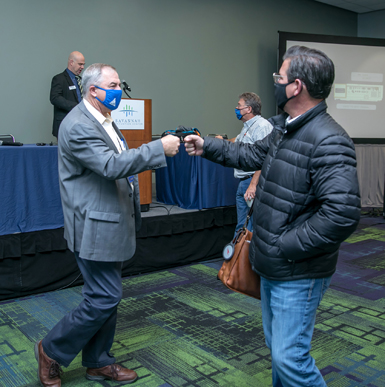 An attendee fist-bumps Air Tractor President Jim Hirsch (left) at the Air Tractor Session. An attendee fist-bumps Air Tractor President Jim Hirsch (left) at the Air Tractor Session.
Air Tractor President Jim Hirsch conducted the Air Tractor Session. He began by reviewing how the company had responded to the COVID-19 pandemic. The plan followed at the factory includes frequent hand-washing, daily cleaning and disinfecting, providing masks and hand sanitizer for each employee and daily health screening. This response allowed Air Tractor to mark its 46th year of uninterrupted aircraft production.
Hirsch then provided attendees a synopsis of 2020 production. In 2020, 119 Air Tractors were produced. The top airplane manufactured was the AT-802A, with 31 built during 2020. The AT-502B was next with 23 built, followed by the AT-502XP at 16 manufactured. Air Tractor has manufactured 92 AT-502XPs since 2016. The forecast for 2021 is to produce 130 Air Tractors.
One of the latest planned improvements at the Air Tractor factory is “inspect vision.” This is an automated optical inspection system that scans parts and then compares them to the part’s drawing to verify the part has been accurately manufactured. For 2021, Air Tractor will be renewing a paint booth and its spar mill.
Hirsch went on to talk about maintenance training, which is free with the purchase of an Air Tractor. COVID-19 has caused a delay in this training, but new dates will be posted soon to Air Tractor’s website.
There are several new products for Air Tractor’s models, including CapstanAg’s SwathPRO system, which will improve application accuracy and is in the process of getting an STC. Also new is the Trotter Gen III Fire Retardant Dispersal System (FRDS), which is now fully FAA approved. Now standard equipment on AT-602s and AT-802s is the new tailwheel and axle, which is easy to grease, has long life bearings and is manufactured from aluminum for better corrosion resistance. A new windshield manufactured by PPG that is lighter and has 10 times more impact resistance will be coming soon, and work continues on the AT-1002 and the certification process. Hirsch said he felt a renewed sense of confidence that the AT-1002 will get finished.
The session finished up with reminders about service letters. Hirsch stressed the fact that clean fuel, air and oil will prevent 80% of service events. Service letter 320 deals with the engine air filter—environmental operating conditions determine the service interval. Hirsch reminded operators who apply fertilizer to ensure the airplane’s nose is pointed into the wind while loading fertilizer so that the dust blows away from the engine. Air Tractor is working on an x-flow filter for ram air.
AeroShell 560 High Thermal Stability (HTS), a cleaner oil that does not darken, is now approved. Pratt & Whitney Canada service instructions provide details for introduction into in-service engines. Flap torque tubes can experience cracks at the actuator bracket weld. Service letter 347 covers this issue, and Air Tractor expects the FAA to issue an AD for the flap torque tube. For V struts on the AT-802 and AT-802A, service letter 383 covers cracks that can occur across the tube near the V weld. A design change has been made to prevent the cracks.
Hirsch closed by reminding the audience that service manuals and maintenance tip videos are available on the Air Tractor website for Air Tractor owners. Current maintenance tip videos include x-flow air filter service, trim your Air Tractor plane, weight and balance and brake bleeding.
Thrush Aircraft Session
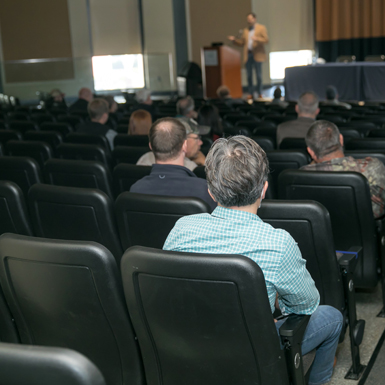 Thrush President and CEO Mark McDonald speaks at the Thrush Aircraft Session. Thrush President and CEO Mark McDonald speaks at the Thrush Aircraft Session.
Mark McDonald, president and CEO of Thrush Aircraft, started its session by relating that the current ownership and management of Thrush Aircraft is a little over a year old. The most often asked question he has received is, “Are you glad you purchased Thrush Aircraft?” The answer, he said, is a definite yes!
Some of the plans made for 2020 were to stabilize the business, improve service, develop and support dealers and create a team. McDonald believes they have made headway on all these goals.
Thrush Aircraft produced 19 aircraft in 2020 and plans on producing 40 aircraft in 2021. McDonald said the goal going forward is to deliver on promises made and that the company will not start big projects until they can be delivered. One project Thrush has started is certifying the PT6A-140 series engine in the 510 airframe.
Thrush also is working on providing product and service options for GE engine owners who would like to do something different. McDonald reported that Thrush Aircraft is still working with GE. GE plans to have three spare engines in the U.S. and one in Canada before the 2021 season starts, and it plans to improve service centers and inventories.
Thrush is interested in helping with safety in ag aviation, specifically regarding human factors. McDonald is concerned that they have not received any calls on safety issues and is willing to work with NAAA and other OEMs. Thrush intends to make its flight simulator more available and will have new training modules in three to four months.
NAAREF Safety Session
The NAAREF Safety Session covered two very important safety topics: how to dump a load in an emergency safely and how to land with a fully loaded aircraft. The topics were covered using two videos that included both classroom and aircraft footage courtesy of Fran de Kock of Battlefords Airspray in Canada. He graciously allowed NAAREF to film him instructing his students on how to safely dump and safely practice dumping and how to land with a loaded airplane.
In the video on emergency load dumping, de Kock notes that in his experience, a deficiency in ag pilots is the ability to dump loads and react to emergencies. He has had many students who have dumped one load in their life, and it scared them to the point they never tried it again. He feels the reason they have scared themselves so badly is that they have put a load in their airplane, gone up to altitude and dumped the load at full power and full cruise. The aircraft responds by pitching up drastically, to the point where it could cause an accident.
In an emergency such as an engine failure or trying to get off the strip or clear an object on takeoff, the aircraft will not be traveling nearly as fast, which is a crucial difference to how many pilots practice dumping. When dumping, the airplane is very controllable when the speed is low, but it pitches up violently when the speed is high. He gave an example of experiencing engine failure in a spray run when you have quite a bit of load left in the airplane. The first thing you should do is dump the load. Two things have happened in this situation—you’ve lost your acceleration and your airspeed is decreasing. De Kock is not worried about the nose pitching up at all in this situation because of the loss of acceleration; he’s worried about the end result of landing safely. Dump the load and fly the airplane.
In his AT-504 with a student, de Kock demonstrated how to practice dumping, simulating an engine failure emergency on takeoff by cutting back power just as the student got airborne. In a debrief after the dump, de Kock explained to the student that he should have nudged the aircraft’s nose forward a little more when he began to feel it shake to translate the energy of losing the load into airspeed. Instead, the student had let the aircraft continue to go upward and it began shuddering. He reminded the student that this was a simulated emergency and gave the student the engine back, but the engine would not be coming back in a real emergency.
In a real engine loss situation, the energy gained from dumping the load would need to be translated into airspeed. Then the pilot would need to set the aircraft up into a landing configuration and get it down safely. He reminded the student that he would not have time to feather the prop in such an emergency. On the student’s second training dump, he successfully captured that aircraft’s energy from dumping the load and converted it into airspeed. The student basically rolled the aircraft’s nose over, and he could have put flaps on and successfully landed had it been a real emergency and not a training exercise.
De Kock then pointed out there is a big difference between losing an engine, where you need to roll the nose over and land, and not being able to get off the runway or clear an obstruction. In those two situations, the engine is still performing, so when you begin to dump the load, you need to get altitude to clear the end of the runway or obstruction. In these situations, the energy of losing the load is converted into altitude instead of inertia.
Next, de Kock addressed the notion that many pilots just want to dump enough of the load to get off the strip. He firmly stated that he does not believe in that for either training purposes or in real-life emergencies. He feels the pilot should get rid of the whole load because, at this point, you’re in trouble. You don’t want to be worrying about whether or not milking off 100 gallons will allow you to make it. He instructed his students to dump the whole load and then fly the airplane. Many people will talk about not wanting to dump the load unless you absolutely have to because of the cost of the load. He contrasted the cost of the load versus the airplane’s cost or possibly even the pilot’s life. In reality, the load is by far the cheapest thing to lose.
Returning to how to respond to an engine failure at takeoff, de Kock reiterated that dumping the whole load will give you inertia, which can be translated into enough airspeed to land safely. You will want to touch down in the soft field configuration in that situation, touching down as slow as you possibly can with the flaps out. He stated that dumps on takeoffs that are required because of anything other than engine failures are self-induced. He gave an example of a pilot working off an unfamiliar strip who didn’t recognize density altitude and couldn’t quite get airborne. This is self-induced because the pilot should have had a smaller load in the airplane. This scenario was also covered for the students in the AT-504. Immediately after dumping, the airplane was in the air and climbing away.
Also important is setting up the gate for dumping. The gates can be set up so that when the pilot pushes forward on the dump handle, they totally release. The initial part of dump training is to make sure the mechanism is working. De Kock has seen gates that have been tightened so much in an attempt to stop leaking that they could not get the gate to discharge without breaking something. Practice using the dumping mechanism on the ground to make sure it works correctly and that you know how to use it. A pilot should be able to hit the dump handle without looking at it. A final tip de Kock provided on training for dumping a load is not to make closing the gate right away a top priority. During a real emergency, you won’t care about the gate at that point, so don’t worry about it in training either. If you had an engine failure, you would have many other things to do besides closing the gate. Fly the airplane.
The second video covered the dumping of landing with a fully loaded aircraft. De Kock explains that landing with a load is a situation generally worth avoiding, but some situations can force a pilot to return with a full load. This means every pilot must be able to land the airplane loaded, and with training and practice, it can be done successfully. You need a good surface and a plan. Control inputs have to be perfect. The aircraft needs to be in good working order, and the tailwheel lock has to be functioning correctly. In his first lesson, he takes the controls of the AT-504 and demonstrates to one of his many students how to land with a load. He explains that everything has to be done right.
According to de Kock, a pilot needs to be aware of differences in airspeed and using power because you can get behind the power curve very quickly. He also stressed that pilots should reduce their angle of approach when landing with a load so that the round-out phase of the landing is not as critical. If you do a more normal round-out, carry a little extra airspeed and bleed it off over the runway.
In terms of approach speed, de Kock’s rule is 20% higher than a pilot’s normal approach speed. If you normally approached at 80 mph, you would want to be almost 100 mph when landing loaded. You will lose speed in a hurry because the wing will decelerate quickly since it is carrying more weight than usual. According to de Kock, you are better off approaching a little too fast rather than a little too slow; it’s easy to bleed off excess speed.
The first attempt by the student to land loaded was a little off. The student was overreacting on the controls and let the aircraft porpoise. De Kock reminded him he needs to make a smooth transition from flying to the ground. The student’s second attempt was much improved.
When practicing landing with a load, you don’t want your first attempt to be fully loaded. Learn how the airplane will react by starting with smaller loads before working up to a full load. If things start to go awry during a loaded landing attempt, de Kock says add power and go around for another attempt. It is easier to redo the landing setup properly than to try and fix a landing that isn’t going well.
When flying a turbine, don’t bring the power below 70% because if you need power, you’re going to want it in a hurry. De Kock also recommends getting rid of the flaps once the main/fore landing gear is firmly on the ground because “you don’t want that wing to still be thinking about flying.”
In closing, de Kock stated you need to land with extra speed and very good control inputs. A pilot must have a good landing approach. If the approach isn’t good, you won’t execute a good landing. Give yourself plenty of extra room and set the landing up farther back than usual so that you know what the aircraft feels like on the controls. Respect the airplane, respect the speed, respect your abilities and know your limitations.
MENTORING OFFERINGS
Compaass Rose Session
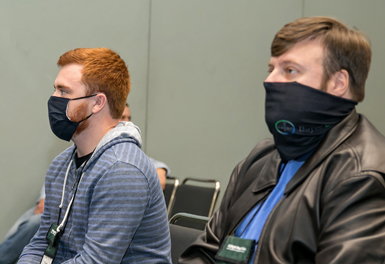 Twenty-two low-time pilots attended the 2020 Compaass Rose Session in Savannah. Twenty-two low-time pilots attended the 2020 Compaass Rose Session in Savannah.
The PAASS Compaass Rose series is designed to provide professional support and direction for agricultural pilots who are new to the industry and people who want to learn more about the industry and what it takes to get into ag aviation. The goal is for participants to enhance their knowledge, continue to gain agricultural aviation experience and improve their professionalism.
The Compaass Rose format was updated in 2017 to create an environment even more favorable for those pilots new to the industry or looking to get into it. Two PAASS presenters led this year’s session: Matt Hovdenes and Mike Rivenbark. After brief introductions, 22 pilots with approximately five years of experience or less were moved to a different room. A series of multiple-choice questions were then asked of both groups, with participants answering using mobile polling. While each group was asked slightly different questions, they addressed the same topics. Both groups were asked about their experience level to get a sense of experience in the room. The questions then went on to address both groups regarding mentoring, safety, priorities and communications.
Having the groups split up allowed the participants to discuss their answers in a judgment-free zone. After each group discussed the topics, they reunited to review their responses to the survey questions together. The whole group discussed each topic with an emphasis on areas where there was greater variance between the more seasoned pilots and newer pilots’ views. On many of the topics, there was a surprising amount of agreement between the two groups. For example, most of the experienced pilots and most of the new pilots expected a new pilot to start at a non-flying position with the company. On a question about what operators look for in a potential employee, attitude and ethics rated higher than flight experience.
Speed Mentoring Session
NAAREF’s “Ask the Expert” Speed Mentoring Session was once again one of the more popular events for pilots new to the industry. The Monday afternoon timeslot allowed new pilots to meet more seasoned industry members early in the week, allowing for more ample networking opportunities throughout the show.
The mentors included operators, pilots and representatives from the insurance industry. The 32 mentees were divided up between seven tables to provide for distancing. Two to three mentors staffed each table. A total of 18 mentors helped with this event. After brief introductions, mentees asked questions for 25 minutes before the mentors rotated to different tables. This format allows for a more direct, personal interaction and benefits mentees by allowing them to hear views from several different perspectives.
The mentees in the groups varied from pilots with no agricultural experience to pilots with up to five years of agricultural application experience. The pilots had a range of questions, including how to get the first seat, how to transition to turbine aircraft and how to safely operate in the low-level environment. Some also had questions about starting their own business or being managers of an existing business.
Much of the discussion centered around how to build relationships with potential employers and how to pick a company for which the pilot would want to work. Mentors stressed the importance of loyalty and how much additional cost is incurred by employers when taking on an inexperienced ag pilot, such as time invested and increased insurance premiums. This is a small industry, and attitudes and work ethic follow pilots as they progress in it.
The conversations would have continued long past the time allotted if schedules would have permitted. NAAA would especially like to thank the 18 mentors and organizers for this quality session. The mentors included Wes Sharp, Sam Rogge, Terry Jordan, Craig Craft, Brenda Watts, Matt Regier, Riley Farder, Billy Whitfield, Michael Rutledge, Mike Rivenbark, Matt Crabbe, Al Schiffer, Matt Hovdenes, Perry Hofer, JT Helms, Doug Davidson, Tim Bonnell Jr. and Vaugh Tolbert.
In Closing …
We could go on, but we’ll save other details about the convention, including details of 2020’s best and brightest acknowledged at the concluding Excellence in Ag Aviation Banquet, for the next issue of NAAA’s magazine. If you like what you learned in Savannah or read here, save the dates for Dec. 6–9, 2021, and join us in Palm Springs, California, at our 55th annual Ag Aviation Expo.

|
|
|
| This newsletter is intended for NAAA members only. NAAA requests that should any party desire to publish, distribute or quote any part of this newsletter that they first seek the permission of the Association. The views, thoughts, and opinions expressed herein do not necessarily represent those of the National Agricultural Aviation Association (NAAA), its Board of Directors, staff or membership. Items in this newsletter are not the result of paid advertising and are only meant to highlight newsworthy developments. No endorsement by NAAA is intended or implied. |
|
|
| FOLLOW US |

|

|

|
| IN THIS ISSUE |
|
|
|
|
|
|
|
|
|
|
|
|
| In Case You Missed It! |
|
|
|
|
|
|
| CALENDAR OF EVENTS |
Full Calendar of Events |
|
|
|
| AG AVIATION HOTLINKS |
|
|
| TOOLS |
|
|
|